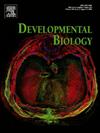解码细胞的命运:Notch和受体酪氨酸激酶信号如何指定果蝇R7光感受器。
IF 2.5
3区 生物学
Q2 DEVELOPMENTAL BIOLOGY
引用次数: 0
摘要
果蝇R7光感受器被指定的过程已经成为理解细胞-细胞信号如何直接细胞命运的经典模型。在R7前体细胞中,Notch和受体酪氨酸激酶(RTK)信号通路都是活跃的,它们编码的信息指导R7光感受器身份的规范。在这一过程中,Notch发挥着三种不同的功能:既反对又促进RTK通路指定光感受器命运的作用,并决定指定的光感受器类型。RTK通路驱动phyl的转录,phyl是光感受器规范所必需的基因表达。我们发现Notch活性可诱导编码phyl转录抑制因子的yan基因的转录。这定义了两种途径之间的拮抗作用,RTK促进而Notch反对phyl转录。我们之前的研究表明,Notch活性为R7前体提供seven - less,从而允许RTK通路过度激活以克服Notch抑制,现在我们确定Yan活性的调控是RTK和Notch信号通路整合的一个位点。一旦细胞被指定为光感受器,第三个Notch功能就会阻止7 -up (svp)转录。Svp转录因子指导R1/6感光受体的命运,防止其表达确保默认的R7规范。本文章由计算机程序翻译,如有差异,请以英文原文为准。

Decoding a Cell's Fate: How Notch and receptor tyrosine kinase signals specify the Drosophila R7 photoreceptor
The process by which the Drosophila R7 photoreceptor is specified has become a classic model for understanding how cell-cell signals direct cell fates. In the R7 precursor cell, both the Notch and receptor tyrosine kinase (RTK) signaling pathways are active, and the information they encode directs the specification of the R7 photoreceptor identity. In this process, Notch performs three distinct functions: it both opposes and promotes the actions of the RTK pathway to specify the photoreceptor fate, and it determines the type of photoreceptor that is specified. The RTK pathway drives transcription of phyl - a gene expression necessary for photoreceptor specification. We show that Notch activity induces transcription of the yan gene which encodes a transcriptional repressor of phyl. This defines an antagonism between the two pathways, with RTK promoting and Notch opposing phyl transcription. We previously showed that Notch activity supplies Sevenless to the R7 precursor to allow the RTK pathway hyperactivation required to overcome the Notch repression, and we now identify the regulation of Yan activity as a site of integration of RTK and Notch signaling pathways. Once the cell is specified as a photoreceptor, the third Notch function then prevents seven-up (svp) transcription. The Svp transcription factor directs the R1/6 photoreceptor fate, and the prevention of its expression ensures the default R7 specification.
求助全文
通过发布文献求助,成功后即可免费获取论文全文。
去求助
来源期刊

Developmental biology
生物-发育生物学
CiteScore
5.30
自引率
3.70%
发文量
182
审稿时长
1.5 months
期刊介绍:
Developmental Biology (DB) publishes original research on mechanisms of development, differentiation, and growth in animals and plants at the molecular, cellular, genetic and evolutionary levels. Areas of particular emphasis include transcriptional control mechanisms, embryonic patterning, cell-cell interactions, growth factors and signal transduction, and regulatory hierarchies in developing plants and animals.
 求助内容:
求助内容: 应助结果提醒方式:
应助结果提醒方式:


